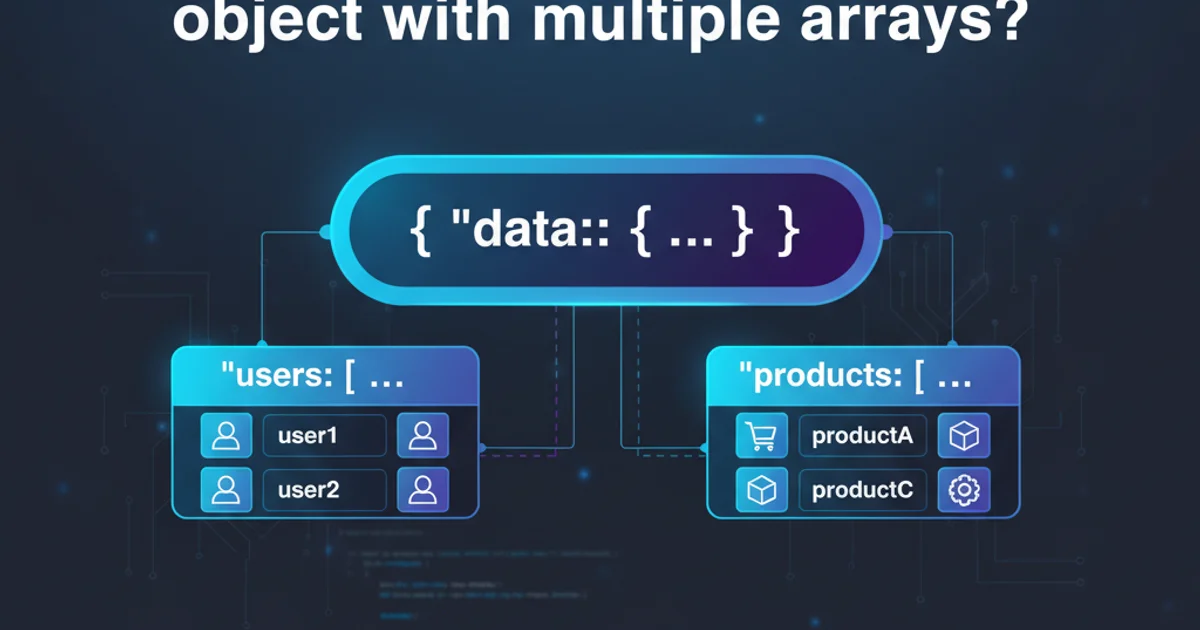How do I make a JSON object with multiple arrays?
Categories:
Crafting JSON with Multiple Arrays: A Comprehensive Guide

Learn how to structure JSON objects that contain multiple arrays, a common requirement for complex data representation in web development and API design.
JSON (JavaScript Object Notation) is a lightweight data-interchange format that is easy for humans to read and write and easy for machines to parse and generate. It's built on two structures: a collection of name/value pairs (an object) and an ordered list of values (an array). Often, you'll encounter scenarios where you need to represent more complex data, such as an object containing several distinct lists of items. This article will guide you through the process of creating JSON objects that effectively incorporate multiple arrays, ensuring your data is well-structured and easily consumable.
Understanding the Basic Structure
Before diving into multiple arrays, let's recap the fundamental JSON structures. An object is defined by curly braces {} and contains key-value pairs. An array is defined by square brackets [] and contains an ordered list of values. To include an array within an object, you simply assign an array as the value to a key. To include multiple arrays, you assign each array to a different key within the same object.
flowchart TD
A[JSON Object] --> B{Key-Value Pairs}
B --> C[Key1: Value1]
B --> D[Key2: Value2]
C --> E[Scalar Value (e.g., String, Number, Boolean)]
D --> F[Array Value (e.g., [item1, item2])]
F --> G[Multiple Arrays within Object]
G --> H[KeyA: [Array1]]
G --> I[KeyB: [Array2]]Basic JSON structure with arrays
Constructing an Object with Multiple Arrays
The process involves defining an outer JSON object and then, for each array you wish to include, creating a unique key and assigning an array as its value. Each array can contain any valid JSON data type: strings, numbers, booleans, other objects, or even other arrays. This flexibility allows for highly complex and nested data structures.
{
"reportId": "RPT-2023-001",
"reportDate": "2023-10-26",
"productsSold": [
{
"productId": "P001",
"name": "Laptop",
"quantity": 2,
"price": 1200.00
},
{
"productId": "P003",
"name": "Mouse",
"quantity": 5,
"price": 25.00
}
],
"customers": [
{
"customerId": "C101",
"name": "Alice Smith",
"email": "alice@example.com"
},
{
"customerId": "C102",
"name": "Bob Johnson",
"email": "bob@example.com"
}
],
"errors": []
}
Example of a JSON object containing multiple arrays (productsSold, customers, errors).
Practical Use Cases and Best Practices
JSON objects with multiple arrays are incredibly useful for representing data that has distinct, yet related, collections. Common use cases include API responses that return different types of entities (e.g., a list of users and a list of their permissions), configuration files with multiple sets of parameters, or reports that aggregate various data points.
Best Practices:
- Descriptive Keys: Use clear and concise key names for your arrays (e.g.,
"users","orders","settings") to improve readability. - Consistency: Maintain a consistent structure for objects within each array. For instance, all objects in a
"products"array should have"id","name", and"price"fields. - Empty Arrays: It's perfectly valid and often good practice to include empty arrays (
[]) if a collection might not have any items, rather than omitting the key entirely. This signals that the collection exists but is currently empty. - Validation: Always validate your JSON structure against a schema (like JSON Schema) if possible, especially when dealing with complex data, to ensure data integrity.
import json
data = {
"event": "Conference 2023",
"attendees": [
{"id": 1, "name": "John Doe", "status": "registered"},
{"id": 2, "name": "Jane Smith", "status": "checked-in"}
],
"sessions": [
{"sessionId": "S01", "title": "Keynote", "time": "09:00"},
{"sessionId": "S02", "title": "Workshop A", "time": "11:00"}
],
"sponsors": []
}
json_output = json.dumps(data, indent=2)
print(json_output)
Creating a JSON object with multiple arrays in Python.
const data = {
event: "Conference 2023",
attendees: [
{ id: 1, name: "John Doe", status: "registered" },
{ id: 2, name: "Jane Smith", status: "checked-in" }
],
sessions: [
{ sessionId: "S01", title: "Keynote", time: "09:00" },
{ sessionId: "S02", title: "Workshop A", time: "11:00" }
],
sponsors: []
};
const jsonOutput = JSON.stringify(data, null, 2);
console.log(jsonOutput);
Creating a JSON object with multiple arrays in JavaScript.